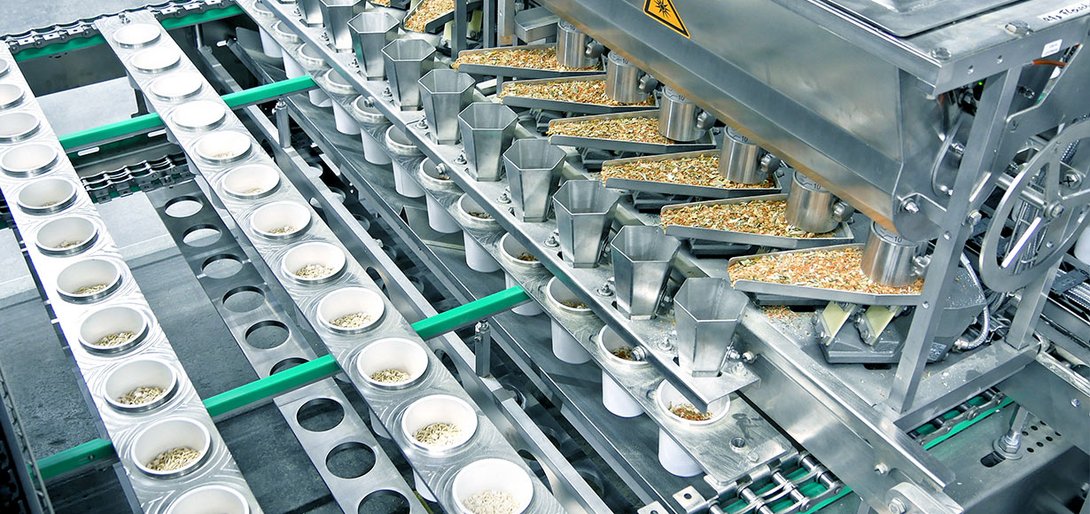Into the cup – ready – go
How do you prefer to eat your noodles? As a side dish, as a noodle main course with a delicious sauce or simply as a snack-to-go? People’s eating habits seem to be changing in general. Consumers’ eating habits depend on many different factors. They often refl ect current trends and the zeitgeist of the moment. For example, sustainable nutrition has been very popular with many consumers for years. However, this does not necessarily imply a contradiction to quick and easy food preparation.
The results of the Trend Report Nutrition 2023, published by the Federal Centre for Nutrition in cooperation with the nutrition network Nutrition Hub at the beginning of the year, also confirm the change in eating habits: According to the report, more and more people are combining a healthy and sustainable diet with the use of ready-made meals that can be prepared quickly and easily, so-called convenience food. What consumers also value here, however, are wholesome and environmentally friendly ingredients as well as resource-saving and recyclable packaging.
Demand for instant noodle dishes is on the rise
In line with this trend, the demand for instant noodle dishes is increasing enormously in many countries around the world. Food manufacturers are accordingly launching products on the market in which they process high-quality and sustainably produced ingredients and pack them in environmentally friendly cups. This is also the case with an international food company that combines the aspects of convenience and sustainability in a special way in an instant noodle product. For this product, the manufacturer combines pre-fried noodle nests with highquality vegetables, selected herbs and spices, and sometimes with a meatingredient, and offers them in a recyclable cup. Consumers only need to pour on hot water and can immediately enjoy a filling, inexpensive and wholesome meal. However, the creation of the finished product and, above all, the filling of the noodle cup with the individual ingredients, as well as the final sealing, are extremely complex. To ensure maximum productivity and economic efficiency, the entire process must be carried out at high speed and automated throughout. The high quality requirements of the product demand a great deal of competence and experience from the manufacturer of the packaging system. Dosomats from Waldner master the complicated sealing technology particularly well. This system precisely addresses the customer’s special requirements. In close cooperation with the customer, Dosomat experts have adapted it individually to the product at hand, the packaging and the corresponding filling process.
480 cups per minute
“The task is to fill pre-formed, deep-fried noodle cakes precisely into empty cups. These are first turned upside down and placed over the cakes,” says Adrian Herrmann, sales specialist at Waldner Dosomat, explaining the principle of the system. During the rotation of the entire package, the noodle cakes are inserted into the cup and further ingredients such as herbs, soup vegetables, spices, broth powder and, depending on the flavour, optional pieces of meat can be added. In addition, a sachet containing a seasoning liquid such as soy sauce is placed on top of the product before the filled cup is sealed airtight with an aluminium lid. Within this workflow, the Dosomat is capable of filling 480 cups per minute. “The high process speed presented us with enormous challenges. In order to precisely maintain the cycle time, the system has to process twelve cups at a time. This means that each individual process step must be completed within 1.5 seconds,” Herrmann explains. In addition, the engineers were confronted with further challenges. For example, the Dosomat is directly preceded by a machine that produces the noodle cakes. It was then necessary to integrate this continuous sequence into the work cycle of the Dosomat and to synchronise both machines perfectly with each other. Another challenge is to provide sufficient packaging material to maintain the fast cycle times. The solution was to optimise the handling of the material supply. This allows operators to manually feed larger stacks of cups to the line, creating a certain buffer time. This ensures that the required material is supplied quickly and in line with demand.
Efficient filling processes
In addition to the enormous speed, this also enables the filling process to be highly efficient.
This is achieved, among other things, by the so-called “no-cup-no-fill principle”:
The system detects individual cups that do not meet the required quality due to material defects and automatically rejects them before filling. This prevents process disruptions and ensures maximum overall equipment effectiveness (OEE). All work stations of the Dosomat can be pulled out so that they are freely accessible for repair and cleaning processes. In this way, maintenance times are reduced to a minimum despite the large dimensions of the system (15 metres long and two metres wide), which in turn increases efficiency and productivity. The complete production of the packaging system – from the conception, development and creation of the system to the production of the individual components and the construction of the switch cabinet and programming of the control system – takes place at the headquarters in Wangen. The customer receives all services from a single source and benefits from the competent support of the Waldner experts throughout the entire life cycle of the machine. Even if the further development of human eating habits is not yet foreseeable - the demand for quick and easy to consume food is unlikely to diminish. Our Dosomats are ready.
